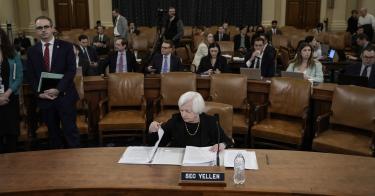If you listen to Treasury Secretary Janet Yellen or President Joe Biden, it sounds like the country will implode if Congress fails to raise the debt ceiling in a couple months. But Biden’s words don't match his actions.
He says hitting the debt limit is an existential threat. But by refusing to meet and negotiate with congressional leaders to discuss it, the Biden administration comes closer to bringing about the very crisis they claim they’re trying to prevent.
Even if it seems Biden isn’t paying attention to the debt ceiling and government borrowing, Americans should be concerned. The runaway inflation of the past few years is a natural consequence of the unchecked government spending.
Though nominal average weekly earnings are up 9% from January 2021, real earnings are down 5.1% because wages have not risen as fast as prices. The debt ceiling negotiation is an opportunity to put an end to the “inflation tax” that’s cutting into Americans’ paychecks.
>>> Heritage President Praises New Debt Limit Proposal
If Congress declines to raise the debt ceiling, then the Treasury is limited to spending only what it receives in tax revenue. The good news is that the Treasury collects more than enough tax revenue to pay the holders of Treasury securities and pay recipients in programs like Medicare and Social Security. The bad news is that Treasury has no plan for how to prioritize payments when the debt ceiling binds, so it’s unclear who would actually get paid.
But the real debt limit is not the one Congress sets for itself. It’s the one the market sets when it refuses to buy any more federal debt. If the government continues to spend money without ever intending to pay for it, investors will eventually stop wanting to buy federal debt. The end result will either be rising interest rates as the government gets closer to default or rising inflation as the government prints money to finance the deficit.
Left unchecked, the spending problem will only get worse. CBO projections show federal outlays rising to 29% of GDP by 2052 while revenues remain flat. Over that same time, debt held by the public would reach 185% of GDP. Continued deficits will eat through the remaining fiscal space before the U.S. reaches a debt crisis, according to one estimate from the IMF.
The responsible policy, therefore, would be to reduce spending to a level that allows the government to pay down the debt back to moderate levels, and to do it sooner rather than later. Any spending above the historical revenue limit of 21% of GDP is not realistic.
Yet the Biden administration acts as if the problem of rising federal debt will eventually go away by ignoring it. They don’t even want to discuss budget reforms. Biden has refused to meet with House Speaker Kevin McCarthy since they last met over two months ago. How can something so vitally important to the president as the debt ceiling not even rate a conversation with House leadership?
>>> How the Debt Ceiling Could Prevent the Next Banking Crisis
By failing to plan ahead, the administration is inviting chaos and hoping that threat pushes House Republicans to cave. Instead of meeting conservatives halfway with compromise reforms to spending, Biden wants his opponents to allow the prodigal spending of the last 15 years to continue by raising the debt ceiling with no reforms attached.
Conversely, McCarthy’s strategy has been to highlight the financial pain government overspending has inflicted upon the American people, and offer reasonable reforms to reduce that overspending. The speaker is preparing reforms that will cap discretionary spending at FY 2022 levels and cap discretionary spending growth at 1% per year. In contrast, the president’s budget has discretionary spending grow at 2.3% per year over the next decade, which costs $2.7 trillion more. Total spending would rise to an unstainable 25% of GDP.
The debt ceiling is one of the few things standing in the way of the White House and the big spenders in Congress. As such, it is also one of the last bulwarks protecting the American people from ruinous taxation and inflation. The administration should stop stalling and help fix the fiscal situation before it gets worse.
This piece originally appeared in MSN





